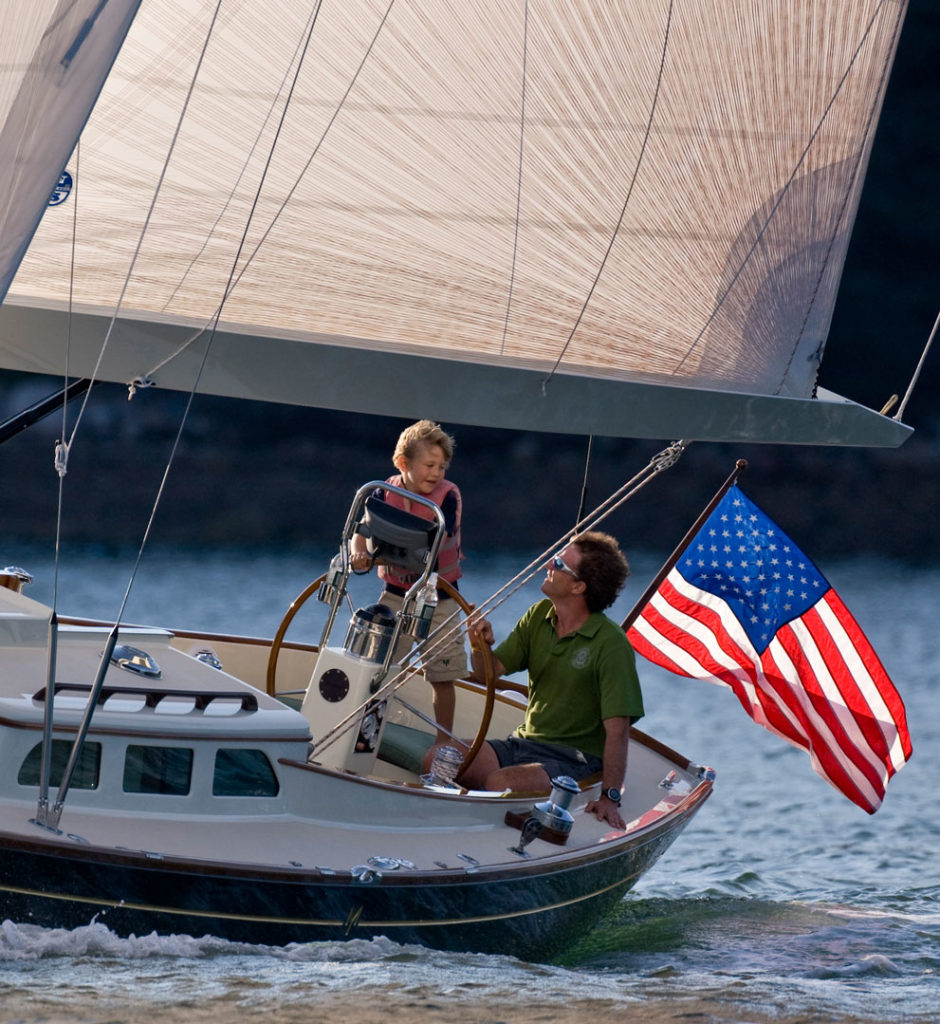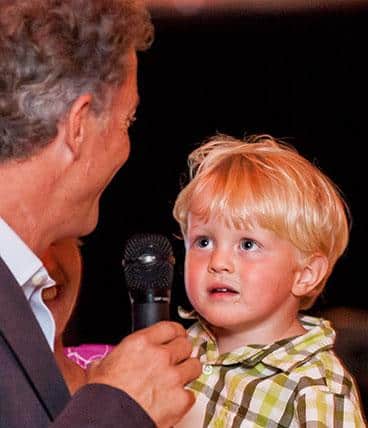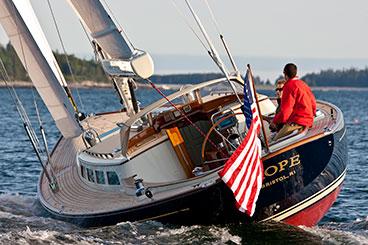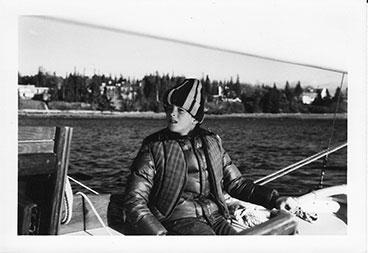
Morris Yachts
On a pristine weekend early last August, more than a dozen boats and several dozen people gathered at Maine’s Northeast Harbor to recognize a legacy 40 years in the making: the first gathering in one place of the family and friends and customers of Morris Yachts since the death nearly four years ago of the man who created it all.
Tom Morris was 32 years old when he loaded up a black VW Beetle and moved his young family from the buttoned-up city life of Philadelphia banking and insurance to Mount Desert Island. The year being 1972, Tom Morris wasn’t alone in choosing to shuck the suit and tie in favor of the more rural life of a craftsman. What distinguished him was the unimpeachable quality of the work he produced. Steeped in his pure love of sailing, that body of work culminated in what one Cruising World Boat of the Year judge recently called “the Rolls-Royce of American boatbuilding.”
But what becomes of Morris Yachts once its founder is gone? It’s a question that no one has wrestled with more deeply than Tom’s son, Cuyler Morris, 47, the president and chief development officer of Morris Yachts. On a shady hill overlooking the working boats and varnished yachts of Northeast Harbor, Cuyler reflected with me on the past, present, and future of the enterprise his father started here 40 summers ago.
TM:_ I visited your dad’s boatshop in Southwest Harbor in 1991 or 1992. Was that the first shop he set up?_
CM: The first shop was on the property behind our house on the High Road. I guess he started building it in the spring of 1973 and built boats there in our backyard for at least two years. Then he bought that tidal property down by the water. He moved the business—physically took the building down the hill—then added on to it over the years. And that’s where the business was from the mid 1970s to 2000.
TM:Was the Frances 26 the very first Morris yacht from those early days?
CM: My dad built the shop and got started finishing off Friendship sloops for Jarvis Newman. He did seven 25-foot Pemaquids or 31-foot Dictators. Then Chuck Paine strolled into his boatyard with the half hull and the drawings for the Frances. Dad was thinking, “OK, I like finishing off Friendship sloops. I want something I can call, you know, a Morris yacht.” And they pretty quickly agreed that they should work together.
TM: **You were 6 or 7 years old at the time. What did you think about it all when you were growing up?
**CM: I hated sailing—because my dad loved sailing. I was like most kids: You hate what your parents do. But you know, I grew up in a boatyard. So I’d come home at the end of the day—the garage door is open, the boat is right there. It was a contact high. I’d go in the cabinetry shop, and Dad would show me how to use the bandsaw.
TM:What changed your mind about sailing?
CM: When I was about 15, the J/24 came on the scene up here. A family friend invited me to come racing. And I thought, “Oh, cool. I can go out on a boat with somebody other than my dad.” We went out, and we won the first race. After that, I really got into the competitive aspect of sailing.
TM:I first came to know of you through your work with the America’s Cup program in the mid-1990s. How did that come about?
CM: I’d spent summers doing deliveries and racing. I wanted to be a pro sailor. I ended up in San Diego for the 1994 Star Worlds. I made the mistake of going over to Mission Bay [the Maine-based PACT 95 America’s Cup team compound] to see people I knew. And all these guys are saying, “You’re going to work with us. We need help. We need some boatbuilders.”

| |At his son Charlie’s age, Cuyler Morris wanted nothing to do with sail boats. But once he learned he could sail with friends, rather than dad, he took to the sport|
TM: **At that point, were you a boatbuilder?
**CM: Honestly, I was thinking, “Yeah, I’m a boatbuilder. I’ve grown up in a boatyard. I’ve dabbled in it.” They were long on people who had sailing résumés. I’ll admit, some of the stuff they thought I could do, I’d never done before. But it came pretty naturally to me. And there weren’t too many redos.
TM: Did you have any thoughts then about joining the family business?
CM: None whatsoever. My dad never sat around the table and said, “Son, you’re going to take over the business. You’re going to start the apprenticeship.”
TM:What changed?
CM: It was spring of 1995. I was a newlywed. The Cup was ending. That’s when my dad called and said, “My service manager has just given notice. And if you’re interested in a job as the service manager, coming to work for me, think about it over the weekend and call me on Monday.” [laughs]
TM:How did you and your dad work together?
CM: The service business is really near and dear to my heart. I like how every day in the service business is people coming in with problems to solve and trying to figure it out in a timely and functional way so that they leave happy. The enjoyment for me wasn’t necessarily the hands-on boatbuilding. That was where my dad ultimately got his pleasure in the business. I was on the competitive side. I get my pleasure out of growing the culture of the business, not so much the boatbuilding. I don’t long to be in the woodshop or in the hull of the boat. My easel is different than my dad’s. I think that’s how we complemented each other.
TM:Until the mid-1990s, Morris built classic cruising sailboats. Then the designs shifted to boats that were going to race some. Was that your influence?
CM: We refer to those early boats as our Heritage Series: the Frances up through the 46, which are the overhang-style hull, trunk cabins, sort of Herreshoff American-style yachts. When it came to the contemporary boats [beginning with the 48-foot Reindeer in 1996], I definitely started to sit in more meetings because it interested me. And I definitely saw an opportunity to start to influence rig design and all that kind of stuff, because of racing. Dad was the interiors and making these tiny spaces work really well. I always said that when he and I were working together, he was more about the inside of the boat and I was more about the outside of the boat—the styling and how it was going to function when it’s moving.
**TM: **The Sparkman & Stephens-designed M Series Yachts are in the daysailer mode. What inspired that direction?

| |Hope, a Morris M52| |

| |From the time he was a young boy, Cuyler Morris has enjoyed picturesque harbors and fine sailboats.|
CM: Dad came back from a London boat show in the late 1990s and said, “You know, our biggest struggle going forward is going to be time. Sailing takes time.” My defining moment was in the early 2000s. A customer said to me, “I’ve owned this 52-foot sailboat for seven years. I’ve spent three nights aboard it. All I do is daysail it. In order to have a cockpit big enough for friends and family, I had to buy a 52-foot boat.”
When we came up with the M36, we thought, “Let’s go away from 48- or 52-footers. Let’s do something 36 feet, get back to our roots.” And we thought, “Well, hey, we build three to five of these Ocean Series boats here. If we could build six of those a year, wouldn’t it be great? We’d be building 10 boats.
Never in our wildest dreams would we imagine that we’d go on to build over 110 M Series boats since 2004.
TM: **You’re just building the last of eight Leadership 44 training boats for the U.S. Coast Guard. What’s that been like?
**CM: David Pedrick designed a great product for the Coast Guard, and we were thrilled that they chose us from the 12 possible builders. And the American sailor should be pretty excited about what the Coast Guard is trying to do. They want to get to know the customer better? That’s a platform to get to know the customer better and understand these “blow boats.”
TM:Has the civilian version of that boat opened any doors for you?
CM: We took it to Annapolis last year. But, you know, it was a little bit of a departure of a look from us. And it’s not because of the boat. I just think that that market’s still pretty quiet.
TM: I_t’s clear that you’ve been thinking a lot about the business and the right scale for it. This year, you separated out the CEO role from your role as president. How did you decide to bring in Doug Metchick as CEO?_
CM: It was something I had been struggling with internally for years. One of the best things I did about three years ago is put together a board of advisors. In the vacuum of my dad—Dad and I were the advisors to each other, and that worked. But when dad was gone, it was definitely, Oooh, this is kind of lonely. The board very softly and then very strongly started beating on the drum of, “You know, you’re not doing what’s in your best interest and in the best interest of the company. This thing’s gotten too big for you to handle.” And I knew that. I like business, but there are other guys who are much better at looking at P&Ls and all that kind of stuff. I understand that finances are important. But I wanted somebody to complement me the way that my dad and I complemented each other. And, you know, the business was always long on artistic creation and developing a great product for people. Doug really brings a great marketing mind. He’s a great communicator. He’s a good businessman. And he’s a really fun guy. I get him and appreciate him. He gets me and appreciates me. It’s only been six months, but I’ve known Doug for seven years.
TM:Going forward, where do you see Morris Yachts heading?
CM: We want to continue to grow our service business steadily. We’re doing it by making our operations here best-in-class, first and foremost. Fix your house first. Or, perfect your house first. Then our strategic plan is to find service properties that we can go into in those appropriate markets. I grew up in this boatyard. I just like boatyards. And I just hate going into a place that’s kind of falling apart, and going, “Wow, this place could be so amazing.” And so I’m just as happy to get a broom out and sweep and kind of make the place look good as Dad was to get a chisel out and get in the bilge of the boat. So, hopefully, we can do that. Organically.
TM:And on the boatbuilding front: Anything new coming down the pike?
CM: We’re going to continue with evolutionary makeovers of the M-Series. And as for the Ocean Series, obviously Chuck Paine has retired and isn’t around to continue that line, so we’re going to be working with somebody different there. We’re selling boats to people all over the world, so we’re looking at designs worldwide. I’m excited to get back to focusing on the Ocean Series. Who doesn’t want to dream about sailing to the Caribbean or sailing around the world?
TM:Well, it seems that you’re at a hopeful place in the history of the whole enterprise, 40 years on.
CM: It’s a huge milestone in this industry. I don’t know what the average life expectancy is for a marine business. Sailing is a great lifestyle. I think it’s medicine for the future for people. Now, if we can just keep it going for another 40 years.







